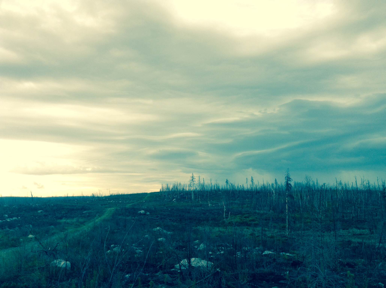Fire in the Boreal and Management
September 2, 2014 2:02 pm Leave your thoughts
The tree plant was not only an incredible opportunity to meet and interact with a variety of people through the tree planters, but also a way to discover, first hand, the many different ecosystems that the Boreal Forest holds within it.
Working in this forest is very different from the temperate rainforests I have studied on Vancouver Island. Here in Northern Ontario, the landscape is simultaneously ancient and young. The bedrock, which is made mainly of banded gneiss and quartz, but also gold, silver, nickel and copper, that make up the soils and landform are the same rocks which formed the foundation of the continent and, in many ways unbeknownst to most people, our national identity of rugged wilderness. The landscape itself, having been so recently deglaciated, holds many lakes, bogs and marshes, a signature of a geologically young landscape. It is an area that commands great respect and awe for its power and beauty. Within this broad classification of “Boreal”, are many other small ecosystems, including mixed forests, swamps/bogs, open woodlands, coniferous forests, and a range of others, most of which I have gotten to experience, through wet feet and hordes of bugs, overwhelming humidity, sun exposure, a mind open to exploring all of it.
This variety of ecosystems maintains a healthy biodiversity in plants, many of which occur only in these areas, as well as animals, ranging from large mammals such as moose and caribou, elusive rodents such as martens, predators such as lynx and wolves, many varieties of fish in the waterways, and, of course, humans and our industry.
Prevalent throughout this range and its varieties of ecosystems, is one entity which rules it all: fire. During the months of our tree plant, one of the major areas which we reforested was a piece of the Timmins 9 fire, which in 2012, swept through almost 40,000 hectares of the Romeo Malette Forest around Timmins. This is one of the most foreign and interesting pieces of wilderness I have ever been privileged to see. Spires of charred Jack Pines and Spruce tower over pioneer growth of various herbs and roses, creating a green carpet to contrast the bleakness of the burned trees. Large fires such as the Timmins 9 and those burning currently in the much more Northern Boreal are drivers of the ecosystem, encouraging the growth of a new generation of Spruce and Jack Pines, which have serotinous or resinous cones that will open only to the heat of fire. Fire events shape not only the ages and species types of the Boreal, but also wildlife habitat and migration patterns (which in turn will also affect the plant and tree life). Reforesting an area such as this is very important, as pioneering species such as poplar, raspberries, and alder will quickly take over the stand, making it difficult to plant the species more valued-softwoods. Our planters worked diligently over really extreme landforms littered with burned debris and standing, blackened chicots, which tear at any exposed skin or through clothing. In the aftermath of the fire, also comes another new complication to the industry- grasshoppers- which I will get into in an upcoming blog post.
(Below is an image taken in plant blocks which had burned in the Timmins 9 Fire)

Everything is connected. Within this ecosystem, one of the most globally important zones in the world, reside millions of species of plants and animals, enough trees to create the majority of oxygen we breathe, as well the economic heartbeat of our nation- natural resources, all of which have to balance. At the basis of every management plan made by this industry, a great respect must be paid towards the ecosystems we are guests within, remembering that without healthy natural systems, we have no future forest.
